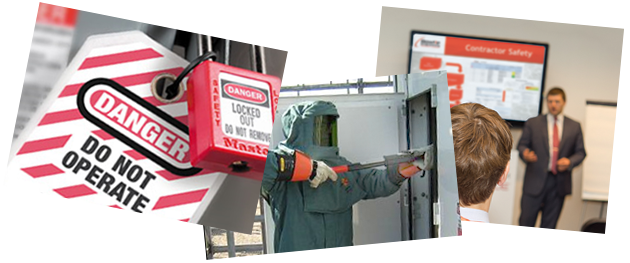Arc Flashes Kill
Arc flashes kill. EACH day, an arc flash kills one to two people. Electrical arc blasts injure another five to ten people. An estimated 80% of all electrical injures are burns from arc flashes igniting people’s clothing. Companies implement electrical safety programs in hopes of safeguarding their people and their property. Unfortunately, those programs aren’t always thorough enough, aren’t implemented correctly, or maintained adequately. This is where Bowtie Engineering™ comes in.
What is an arc flash?
An arc flash is a killer electrical explosion caused when an electrical current leaves its intended path and travels through the air from one conductor to another or to the ground. The explosion arcing fault rapidly heats air molecules, ionizes and vaporizes conductive metal materials and generates an explosion. An arc flash can occur anywhere in an electrical system.
What is an arc flash?
An arc flash is a killer electrical explosion caused when an electrical current leaves its intended path and travels through the air from one conductor to another or to the ground. The explosion arcing fault rapidly heats air molecules, ionizes and vaporizes conductive metal materials and generates an explosion. An arc flash can occur anywhere in an electrical system.
Besides possible injuries or even death, what other consequences can an arc flash have?
When a company experiences an arc flash, especially if it’s serious or deadly, the company faces Occupational Safety & Health Administration (OSHA) citations, heavy fines, lawsuits, increased insurance rates, a damaged reputation, and business interruption.
Do I have to have an Arc Flash Study performed in my facility/business?
The short answer is yes, in an effort to reduce the arc flash risks, OSHA in 2007 issued several mandates requiring employers to adhere to National Fire Prevention Association’s and OSHA guidelines. As a result, for the first time, businesses and government agencies throughout the U.S. are being told that they ‘shall’ protect their workers from electrical hazards in the workplace. Businesses can no longer ignore the dangers of an arc flash. It’s the law. Organizations must protect their employees and others against the dangers of an arc flash electrical explosion. The solution is Bowtie Engineering, a fee-based, customizable Program designed to reduce risk and help an organization meet its governmental obligations.
How dangerous is an arc flash blast?
One to two people die from arc flash while another five to ten more are injured, EVERY DAY. Other statistics show that:
•Arc flashes can kill within a distance of 10 feet from a blast.
•Over 2,000 workers go to burn centers each year with electrical-related burn injuries.
•Emergency rooms report about 8,000 electrical contact injuries annually.
•80% of all electrical injuries are burns from arc flashes igniting flammable clothing.
•One person, each working day, is electrocuted in the workplace.
•Approximately 30,000 nonfatal shock accidents occur every year.
Who sets the standards for arc flash prevention?
In 2007, OSHA mandated that businesses implement arc flash standards. The National Fire Protection Association (NFPA) sets the guidelines for implementing arc flash prevention through its NFPA 70E training manual. What can an organization do to prevent an arc flash? Preventing an arc flash involves a number of steps and processes. Assessing risk, conducting an incident energy study, proper training (including NPFA 70E training) and setting an electrical maintenance program in place, should all be part of any preventive maintenance process.
How does an arc flash injure people?
People are injured by the power of the blast and from the tremendous heat radiated from the explosion. An arc flash, which is four times hotter than the sun, sprays debris in a wide arc, vaporizes copper bus and other components, melts clothing and too often resulting in injuries that can leave a victim with permeant injury/disfigurement and even death.
Arc Flash Study
Why An Incident Energy Study
Bowtie conducts comprehensive Incident Energy Studies to determine the vulnerability of a plant, a building or a company. We use our six-step standardized, proven process based on NFPA 70E and OSHA guidelines and regulations.Bowtie Credentials
• Environmental health and safety experts • ASP, CET, CESP, BCSP • OSHA 500, 501, 511 • NFPA 70E qualified personnel • NFPA 70E approved trainers
Standalone or Integrated
A Bowtie Incident Energy Study can be a standalone service or be part Bowtie’s three-piece integrated service program.
Incident Energy Study Benefits
Bowtie Incident Energy Studies, which go beyond traditional arc flash studies, provide a host of benefits to our customers, including:
• Satisfies OSHA 1910 CFR 29 • Improvements to the electrical safety program


